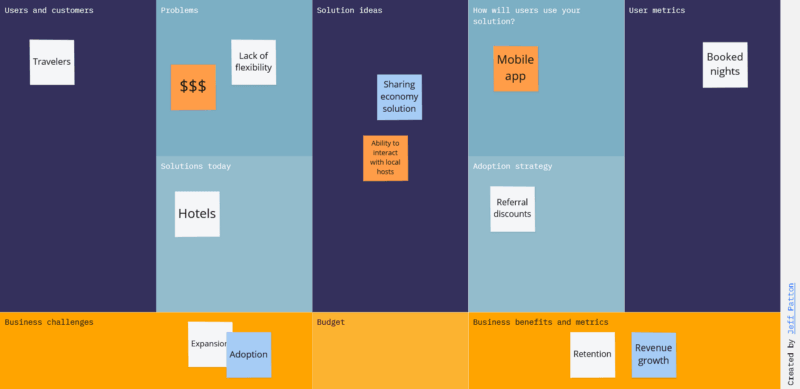Finding focus: Going on a vision quest
— Product Development — 4 min read

Things have been going well in my new venture — Reciprocal.dev, we’ve been able to pull together a prototype map and based on the feedback from that, decided to start creating a company.
Aside from developing the prototype I also started conducting user interviews. This was something I had attempted before with JiffyCV but I did those interviews badly and as a result there wasn’t much insight to be had.
Since JiffyCV though I had read ‘The Mom Test’ and I really wanted to see if I could apply the approach I had learned from the book and get much better results than I had previously.
It worked! By not leading with a mention of an app and instead just focusing on how people were currently tackling the problem I was looking to solve, I got a lot more value from those conversations and this allowed me to iterate over a bunch of follow up questions I had to gain more insight.
It did work too well however. I found myself in a situation where the conversations I was having made it hard to focus on what problems the Reciprocal.dev would solve. It turns out people have too many problems in the space I was looking to work within.
I consulted with Kevin, my co-founder, about how this lack of focus was impacting the user interviews (it’s hard to ask good questions when you don’t know what good looks like) and he suggested we have a ‘Vision Quest’ to explore the topics that were coming out of the chats and make sure we have a solid vision for the product.
Prepping for our quest
Just like any good RPG, the quest started with a gang of adventurers sat in a dingy corner of a tavern plotting their latest escapade using a weathered old map that leads to untold riches.
Ok, if you swap out the following it’s more realistic:
- Gang — 2 people
- Dingy corner of a tavern — Google Hangouts (there was beer though)
- Weather old map — Miro board
- Untold riches — What the vision was for the product (which leads to riches)
I added the main pain points I was hearing about to the Miro board and Kevin set up an Opportunity Canvas which we’d then use to frame those problems in order to understand where we needed to focus our efforts.
The Opportunity Canvas

Kevin’s background is in Business Analysis so he has loads of nifty tools for helping frame a problem. The Opportunity Canvas is one of these tools and it is a sheet divided into 10 sections:
- Problems and Solution ideas — These are separate sections but are done at the same time. This covers off the needs of the user and the solutions to problems that the team has to solve those problems
- Users & Customers — What are the disparate groups of users that have the problems listed out in section 1?
- Solutions Today — How are your potential users currently solving the problem they have?
- Business Challenges — What happens to your business if you don’t solve the problems your potential users are having?
- How will users user your solution — What’s the impact on the way that users work once they start using your solution (positive and negative)?
- User Metrics — What user behaviours can you track that shows that they are getting value from your solution. How will you measure that it’s having the intended outcome?
- Adoption Strategy — How will users discover and adopt your solution. What gets in the way of adoption?
- Business Benefits and Metrics — What customer business performance metrics will be impacted by user’s buying and using your solution?
- Budget — What will building the solution mean to your business’ finances and how much budget should you set aside?
We started by moving all my pain point items into the Problems area and added our existing hypotheses to the Solution Ideas area and worked our way through the sections one-by-one.
After the board was complete we then worked our way through each section again but had detailed conversations about the items. This usually began with grouping the items as there were some common themes and then we’d record the output from the conversations for that section, so we had a summary of our thoughts readily available.
Some of the sections were harder to complete than others, the budget section for instance was a little awkward as we’re bootstrapping a side-project but we stopped thinking about the budget in monitary terms and instead in the amount of time we could invest.
Outcomes from the Opportunity Canvas
The Opportunity Canvas was really insightful and helped to narrow the focus of the product massively by showing how building a tool that supplements existing tooling would be better than building a competitor to more established tools, like some of the pain points users had expressed were suggesting.
This new focus meant that I was able to rework the set of questions I was asking during user interviews to build understanding in that area and it gave me a ‘compass’ for driving the conversation when conducting user interviews.
The new focus also meant we’ve been able to refresh our marketing copy in order to play up the benefits to potential user’s that align with our vision and the business benefits we discussed in section 8 of the Opportunity Canvas.
We were also able to use the new vision to build and prioritise our backlog which has made it easier for me, as switching between user interviews and writing code was a little taxing, but having a solid idea of the direction I need to take things in has reduced this.
Summary
A team works better when it has a clear vision as there’s a shared understanding of what works in moving it towards its goals and what is wasteful.
If you and your team are finding that conducting user interviews is unearthing more problems than you can handle then an Opportunity Canvas can really help you work through what those problems really mean and whether they are worth tackling.